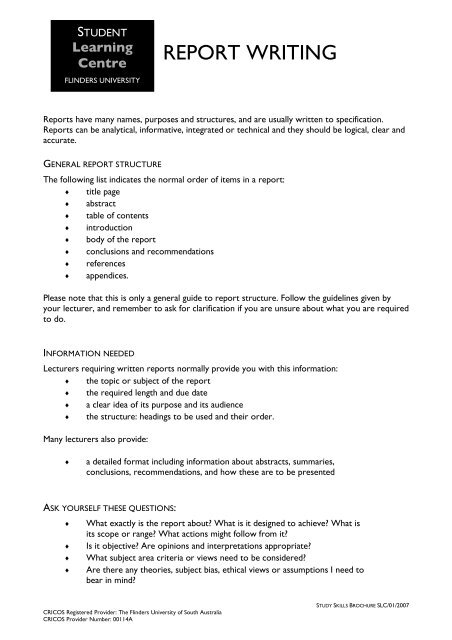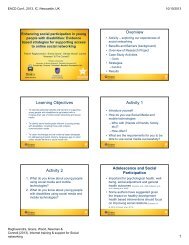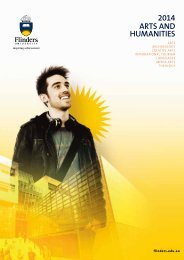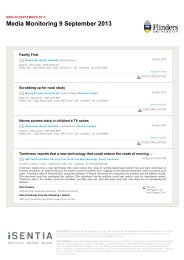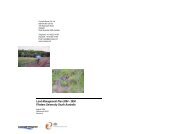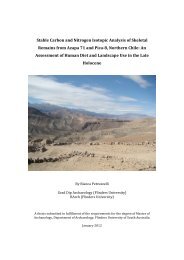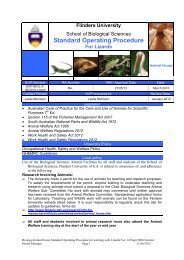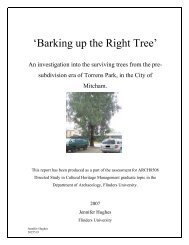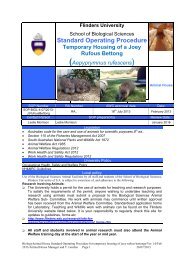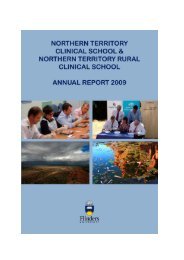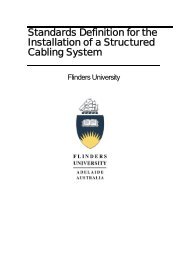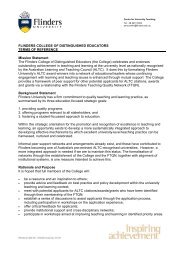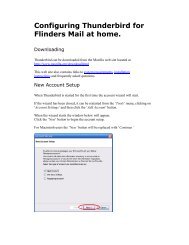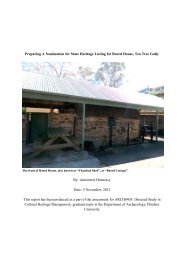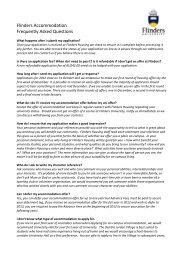REPORT WRITING - Flinders University
REPORT WRITING - Flinders University
REPORT WRITING - Flinders University
You also want an ePaper? Increase the reach of your titles
YUMPU automatically turns print PDFs into web optimized ePapers that Google loves.
STUDENT<br />
Learning<br />
Centre<br />
FLINDERS UNIVERSITY<br />
CRICOS Registered Provider: The <strong>Flinders</strong> <strong>University</strong> of South Australia<br />
CRICOS Provider Number: 00114A<br />
<strong>REPORT</strong> <strong>WRITING</strong><br />
Reports have many names, purposes and structures, and are usually written to specification.<br />
Reports can be analytical, informative, integrated or technical and they should be logical, clear and<br />
accurate.<br />
GENERAL <strong>REPORT</strong> STRUCTURE<br />
The following list indicates the normal order of items in a report:<br />
♦ title page<br />
♦ abstract<br />
♦ table of contents<br />
♦ introduction<br />
♦ body of the report<br />
♦ conclusions and recommendations<br />
♦ references<br />
♦ appendices.<br />
Please note that this is only a general guide to report structure. Follow the guidelines given by<br />
your lecturer, and remember to ask for clarification if you are unsure about what you are required<br />
to do.<br />
INFORMATION NEEDED<br />
Lecturers requiring written reports normally provide you with this information:<br />
♦ the topic or subject of the report<br />
♦ the required length and due date<br />
♦ a clear idea of its purpose and its audience<br />
♦ the structure: headings to be used and their order.<br />
Many lecturers also provide:<br />
♦ a detailed format including information about abstracts, summaries,<br />
conclusions, recommendations, and how these are to be presented<br />
ASK YOURSELF THESE QUESTIONS:<br />
♦ What exactly is the report about? What is it designed to achieve? What is<br />
its scope or range? What actions might follow from it?<br />
♦ Is it objective? Are opinions and interpretations appropriate?<br />
♦ What subject area criteria or views need to be considered?<br />
♦ Are there any theories, subject bias, ethical views or assumptions I need to<br />
bear in mind?<br />
STUDY SKILLS BROCHURE SLC/01/2007
BEFORE RESEARCHING<br />
♦ Write a sentence or thesis statement clarifying the subject and purpose of<br />
the report. This will be useful when you write a report.<br />
NEW INFORMATION<br />
♦ Some reports require new information. Plan experiments, interviews,<br />
measurements, questionnaires and other research methods carefully.<br />
Consider time-lines, length, costs (if applicable), methods and any problems<br />
that may arise.<br />
♦ Make sure the data will be complete well before the due date of the<br />
report.<br />
♦ Request help from your lecturer in designing methods and approaches if<br />
you are uncertain about these.<br />
INFORMATION FROM LIBRARY SOURCES<br />
♦ If the report requires the collating, synthesising or interpretation of<br />
information already published in books, journals and media, reading for a<br />
report is similar to reading for an essay:<br />
♦ Read only what you know is relevant.<br />
♦ Try to write brief notes: either short acknowledged quotations, or<br />
information in your own words. This helps you to understand<br />
the material and to avoid plagiarism.<br />
♦ Keep accurate bibliographical details of all your sources as you read.<br />
Contact your liaison librarian (under ‘Information Services’ on the Library home page) if you are<br />
having difficulty locating relevant information.<br />
<strong>WRITING</strong> THE DRAFT<br />
♦ If you have been provided with headings, use these to form the structure<br />
of your report.<br />
♦ Decide on a numbering system before you start writing the draft. A<br />
decimal numbering system is generally used, for example:<br />
♦ The title of the first main section is numbered 1.0<br />
♦ The first sub heading is 1.1<br />
♦ The second sub heading is numbered 1.2<br />
♦ The title of the second main section is numbered 2.0<br />
♦ The first sub heading is 2.1<br />
♦ The second sub heading is 2.2<br />
♦ The first part in the second sub heading is 2.2.1<br />
♦ The second part in the second sub heading is 2.2.2<br />
♦ Most reports require an impersonal passive style, for example, ‘The<br />
statistics were presented to the committee’, rather than ‘I (or we)<br />
presented the statistics to the committee’. If you are not sure which style<br />
is best for your report, check with your lecturer.<br />
♦ If you need to express uncertainty or doubt, you can use the modal verbs<br />
‘may’, ‘might’ or ‘could’, or adverbs such as ‘perhaps’ or ‘possibly’.<br />
♦ You may choose to use tables, graphs and diagrams, if these are<br />
appropriate for your topic.<br />
CRICOS Registered Provider: The <strong>Flinders</strong> <strong>University</strong> of South Australia<br />
CRICOS Provider Number: 00114A<br />
STUDY SKILLS BROCHURE SLC/01/2007
EDITING<br />
It is important that your report is presented in a clear, straightforward manner.<br />
Make sure that:<br />
♦ the data and facts you have presented are accurate.<br />
♦ any data has been analysed in accordance with your report guidelines.<br />
♦ your conclusions and recommendations follow logically from the data.<br />
♦ all tables, graphs, diagrams and charts you have used conform to your<br />
lecturer’s guidelines.<br />
♦ you have fully met the requirements for this report.<br />
♦ your references (in-text and reference list) are accurate and complete.<br />
♦ the word count (using ‘Word’: Tools → Word Count) is within the range<br />
required for this report.<br />
♦ you have formatted the document in line with your lecturer’s expectations.<br />
PROOFREADING<br />
After editing, proofread your report as you would proofread an essay:<br />
♦ Check for spelling, punctuation, grammar and expression mistakes.<br />
♦ If you are aware of the mistakes you usually make, look for these mistakes<br />
first.<br />
♦ If you are unsure, ask someone else to proofread your work.<br />
♦ Number each page (using ‘Word’: View → Header and Footer) and staple<br />
the essay pages together at the top left hand corner.<br />
♦ Save the document to your computer or to a flashdrive or floppy disk.<br />
REFERENCES<br />
American Psychological Association 1994, Publication manual of the American Psychological Association, 4th edn, American<br />
Psychological Association, Washington.<br />
Barrass, R 1978, Scientists must write: a guide to better writing for scientists, engineers and students, Routledge, London.<br />
Counsell, J 2006, Technical report writing, <strong>University</strong> of Tasmania,<br />
viewed 15 October 2006,<br />
.<br />
Winckel, A & Hart, B 1996, Report writing style guide for engineering students, 3 rd edn, <strong>University</strong> of South Australia<br />
Faculty of Engineering, Flexible Learning Centre, Adelaide.<br />
Windschuttle, K & Elliot, E 1999, ‘Reports: research and analysis’, in Writing, researching, communicating, 3 rd edn,<br />
McGraw-Hill, Sydney.<br />
FURTHER READING:<br />
The Learning Centre: the <strong>University</strong> of New South Wales 2005, Report writing FAQ, viewed 30 August 2006,<br />
.<br />
Detailed guidance of how to write the various sections of a report (including examples)<br />
Uni Learning: the <strong>University</strong> of Wollongong 2000, Report writing, viewed 30 August 2006,<br />
.<br />
A helpful guide to language use in report writing<br />
CRICOS Registered Provider: The <strong>Flinders</strong> <strong>University</strong> of South Australia<br />
CRICOS Provider Number: 00114A<br />
STUDY SKILLS BROCHURE SLC/01/2007
CRICOS Registered Provider: The <strong>Flinders</strong> <strong>University</strong> of South Australia<br />
CRICOS Provider Number: 00114A<br />
STUDENT LEARNING CENTRE<br />
STUDENT CENTRE, LEVEL ONE<br />
TELEPHONE: 61-8-8201 2518<br />
FAX: 61-8-8201 3839<br />
E-MAIL<br />
slc@flinders.edu.au<br />
INTERNET<br />
http://www.flinders.edu.au/SLC<br />
POSTAL<br />
PO BOX 2100, ADELAIDE, SA 5001<br />
STUDY SKILLS BROCHURE SLC/01/2007


